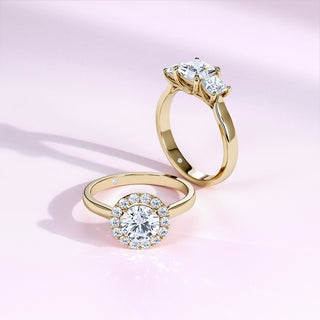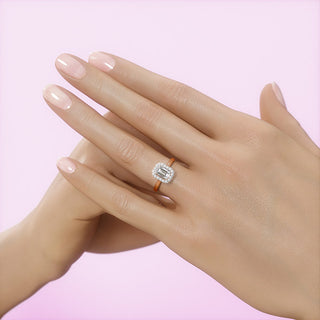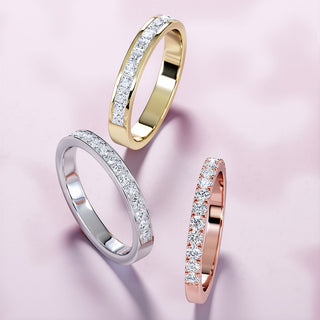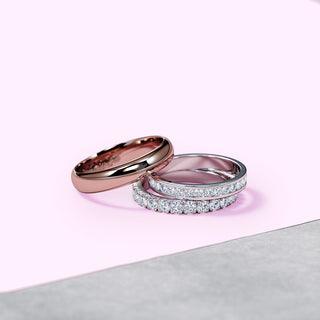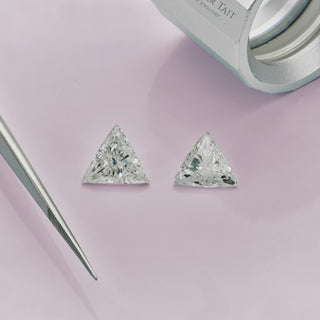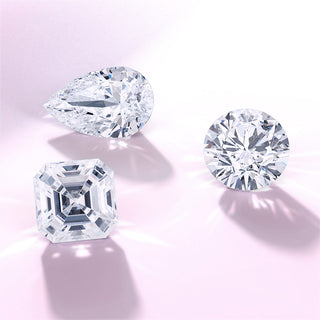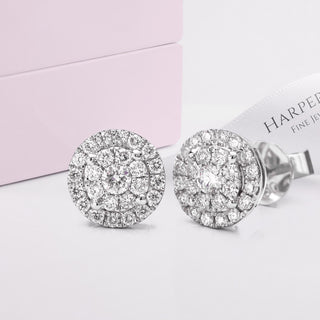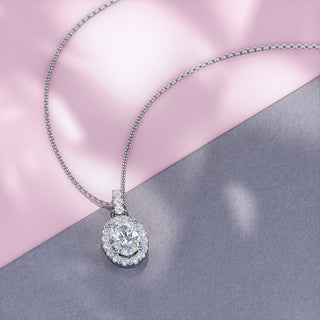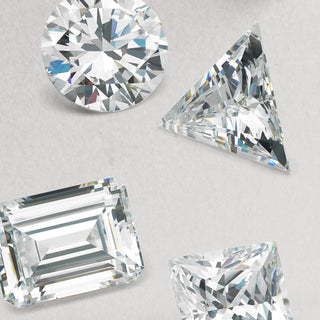When it comes to determining the beauty and value of a diamond, colour is hugely impactful. White diamonds naturally occur in a wide spectrum of hues and shades, from icy white to hints of yellow or brown. The diamond grading scale records how little colour is present in a diamond, with colourless diamonds being the most prized and valuable. In this guide, we’ll explore how colour is graded and why it matters.
Note: this guide refers to white diamonds only, not fancy colour diamonds. Fancy diamonds - which in a rainbow of shades - are graded differently. The deeper and more unusual a fancy colour, the more valuable the stone.

The diamond colour scale: a breakdown
Diamond colour is ranked on a spectrum from D to Z. D-graded colour diamonds are completely colourless, while Z stones have a strongly visible yellow or brown tint.. Each letter in between represents a sliding scale of colour presence, with D - F being the most sought after.
-
D-F: Colourless Diamonds
These diamonds are colourless, appearing perfectly white to the eye when loose or set in jewellery. The rarest colour grade, D-F diamonds are also the most sought after.
At Harper Tait, our signature diamond quality is D-F colour and VS clarity. Drawing no colour, these stones can be set in any piece of jewellery, at any size, and look completely white.
-
G-J: Near Colourless Diamonds
Diamonds in this range are called “near colourless”, displaying (or ‘drawing’) light tints of yellow or brown. In this range we start to see warm tones, particularly in strong lighting or when placed next to colourless stones and cool-toned metal.
-
K-M: Faint Colour
Diamonds in the K-M range show a noticeable yellow or brown tint, very visible to the naked eye. From here, M-Z diamonds are strong in colour, although not deep or vivid enough to be considered a fancy diamond.
What diamond colour means for you
Here at Harper Tait, you’ll find diamonds of all colours and qualities, and colour is a very personal choice. While beautifully white diamonds are the most beloved, some people are happy to consider diamonds with a stronger colour, which tend to be less expensive. Choosing a near-colourless or faint colour diamond may be a way to get a larger or clearer stone within your budget. After all, balancing the four Cs is a matter of deciding what matters most.
Still, it is important to consider how colour might impact a diamond’s appearance when set in your engagement ring. So, what should you consider when making your decision?
Size Matters
The larger the diamond, the more visible any hint of colour will be. For larger diamonds, we recommend choosing a D-F colour to ensure your stone appears as white and brilliant as possible. At lower colour grades the tint may become more noticeable, especially in diamonds over 1 carat.
Diamond Cut and Colour
Some diamond cuts emphasise colour more than others. Step cuts like an emerald (such as the or asscher (such as the Westminster) have large, open facets that make any tint more noticeable. For these shapes, opt for a colourless (D-F) diamond.
Brilliant cuts like a round or cushion may hide slight tints more effectively due to their intense sparkle - but there is little more striking than a brilliantly sparkling, pure white stone!
Metal Pairing
The metal you choose for your ring also affects how a diamond’s colour appears. White metals such as platinum or white gold enhance a diamond’s true colour, making any warmth in lower colour grades more visible. A D-F diamond can be paired with any metal and appear bright and brilliant.
If you prefer the warmth of yellow gold or rose gold, you may have more flexibility with diamond colour, as the warmth of the metal can help to disguise slight tints in diamonds of lower grades.
Melee Harmony
When designing engagement rings or jewellery with accent stones, such as halo settings or diamond-set bands,it is vital these diamonds are perfectly matched with the central stone to ensure uniformity throughout the entire piece.
Fluorescence
Fluorescence refers to a visible ‘glow’ emitted by some diamonds when exposed to UV light. About 25 - 35% of all diamonds display some fluorescence, but it only has a visible impact for a very small percentage of stones.
You may have heard that fluorescence can impact diamond colour. For some diamonds with low colour grades (I-N), having blue fluorescence might make them appear whiter when viewed in daylight. This is due to blue tones neutralising warm colour. For a small number of stones (around 0.2%), strong fluorescence can make a stone appear cloudy or oily.
In the vast majority of cases fluorescence has little impact on a diamond’s colour or overall appearance - there is a reason it is only a noted characteristic, not one of the 4Cs. We recommend considering fluorescence as a secondary factor, but are always happy to provide our expert advice on any individual diamond’s features.
Why we choose D-F colour diamonds
At Harper Tait, we want any diamond you buy from us to bring a lifetime of delight. By offering a signature quality of D-F colour, we can be certain our stones are beautiful and brilliant in whatever piece they are set. By offering lab-created diamonds as a natural diamond alternative, we allow for budgeting without compromising quality.
Diamond Colour FAQs
Is diamond colour more important than clarity?
Both colour and clarity impact a diamond’s appearance and cost. But when it comes to the 4Cs, we always say that none are intrinsically more important than any other. It depends on the individual diamond and your individual preferences.
It can be easy to get lost in specs and figures, playing one off against the other and wondering which combination of characteristics is going to result in the ‘best’ diamond. It is one of the reasons our signature quality is D-F colour and VS quality. With this pairing, every diamond will be beautiful, no compromise.
If you can, visit us in our Hatton Garden showroom where we can show you what diamonds in different gradings and cuts look like. We can help you get a picture of what matters - and delights - you.
Why does Harper Tait only offer D-F colour diamonds?
D-F colour diamonds can be set into any design, in any cut and in any metal, and they will look brilliant and colourless. We want everyone who trusts Harper Tait with their engagement ring to unreservedly love their diamond, and this beautiful colour allows us to be certain of that.
If you buy a diamond from us online without a chance to see it in person, our signature quality ensures you won’t be surprised or disappointed.
Do D-F diamonds work with all metal types?
They do! The D-F colour range is the most versatile, looking brilliant in any metal, from platinum to yellow or rose gold.
What makes D-F diamonds more valuable than lower colour grades?
D-F diamonds are colourless, making them rarer and more sought after than lower grades that draw more colour. Colourless diamonds are beautiful and desirable for engagement rings, wedding bands and fine jewellery of all types and styles.
Download our Diamond Colour Chart here.


